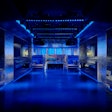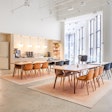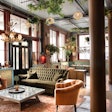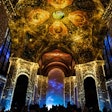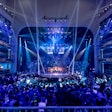Karim Rashid—among the most prolific industrial designers—opened his eponymous New York practice in 1993. Recognized for his work for clients from Prada to Estée Lauder to Sony, the author of 2001's well-received I Want to Change the World has won numerous awards, has 70 objects in permanent museum collections around the world, and has exhibited work at MoMA, the San Francisco Museum of Modern Art, and the Chicago Atheneum.
Do any designers or artists particularly inspire you?
Yes, there are hundreds. In the early 70's when I was getting my education I was very inspired by the radical Italian movement, by people like [multidisciplinary artist-designer] Gaetano Pesce. Someone else I learn from even if it doesn't translate directly into my work is Luigi Colani. He was a crazy organic madman in the 60's and 70's, and I'm very inspired by his amorphous language.
What's the first thing you start with when you're designing a space?
A lot of times the first thing is the subject matter. I use the expression "form follows subject." I like thinking about the whole project holistically. For example, I'm doing a restaurant in Long Island, where the concept revolves around different food for different seasons, using local produce. So I started thinking about seasons, and how a restaurant could change over time.
What do you consider the most important element?
Human experience—regardless of form, material, color, style, design, all these issues. I think they all have to come together for a great human experience. If someone loves a project I do, they don't remember the details. They just walk away with a feeling.
Do you look to another industry for inspiration?
I'm already so broad, and my industrial design field is broad too—I'm already in so many different areas. The world of technology is very inspiring; it's a place of opportunity ad infinitum in that there's so much new process and material. It allows us to set up new social behavior, like telecommunication behavior. I also love music. I was a DJ in the 70's.
What are your favorite spaces?
I like, even if just for a moment, the feeling of being between two metal walls of a Richard Serra sculpture. I also liked being in an installation by [American installation artist] Robert Irwin at the Dia, where he created the rooms made of white cloth—you could see all the shadows.
With whom would you like to collaborate, either again or for the first time?
I'd really like to collaborate with Moby. I like the idea of turning objects into sound, allowing the energy of the forms to create some sort of parametric program so a 3-D form is translated into notes or scales.
How do you start looking for ideas when you first start a project?
I travel nonstop for work—I'm working in 23 countries right now. They're all very inspiring, the different cultures and spaces and cities and architecture. I also like to read. I'm reading Freakonomics by Steven Levitt and Stephen Dubner right now and last month I read Frank Zappa's autobiography.
Where do you come up with your ideas?
I come up with a lot of my ideas when I have insomnia. I wake up at four and can't get back to sleep and all my projects start to come together. That happens about two or three times a week. Another place is the moment I'm talking with a client. My mind races. I want to implant a chip in my brain that could just download my ideas so I don't forget them.
—Eva Hagberg
Posted 08.15.05
Photo: Ilan Rubin (Rashid)
Do any designers or artists particularly inspire you?
Yes, there are hundreds. In the early 70's when I was getting my education I was very inspired by the radical Italian movement, by people like [multidisciplinary artist-designer] Gaetano Pesce. Someone else I learn from even if it doesn't translate directly into my work is Luigi Colani. He was a crazy organic madman in the 60's and 70's, and I'm very inspired by his amorphous language.
What's the first thing you start with when you're designing a space?
A lot of times the first thing is the subject matter. I use the expression "form follows subject." I like thinking about the whole project holistically. For example, I'm doing a restaurant in Long Island, where the concept revolves around different food for different seasons, using local produce. So I started thinking about seasons, and how a restaurant could change over time.
What do you consider the most important element?
Human experience—regardless of form, material, color, style, design, all these issues. I think they all have to come together for a great human experience. If someone loves a project I do, they don't remember the details. They just walk away with a feeling.
Do you look to another industry for inspiration?
I'm already so broad, and my industrial design field is broad too—I'm already in so many different areas. The world of technology is very inspiring; it's a place of opportunity ad infinitum in that there's so much new process and material. It allows us to set up new social behavior, like telecommunication behavior. I also love music. I was a DJ in the 70's.
What are your favorite spaces?
I like, even if just for a moment, the feeling of being between two metal walls of a Richard Serra sculpture. I also liked being in an installation by [American installation artist] Robert Irwin at the Dia, where he created the rooms made of white cloth—you could see all the shadows.
With whom would you like to collaborate, either again or for the first time?
I'd really like to collaborate with Moby. I like the idea of turning objects into sound, allowing the energy of the forms to create some sort of parametric program so a 3-D form is translated into notes or scales.
How do you start looking for ideas when you first start a project?
I travel nonstop for work—I'm working in 23 countries right now. They're all very inspiring, the different cultures and spaces and cities and architecture. I also like to read. I'm reading Freakonomics by Steven Levitt and Stephen Dubner right now and last month I read Frank Zappa's autobiography.
Where do you come up with your ideas?
I come up with a lot of my ideas when I have insomnia. I wake up at four and can't get back to sleep and all my projects start to come together. That happens about two or three times a week. Another place is the moment I'm talking with a client. My mind races. I want to implant a chip in my brain that could just download my ideas so I don't forget them.
—Eva Hagberg
Posted 08.15.05
Photo: Ilan Rubin (Rashid)

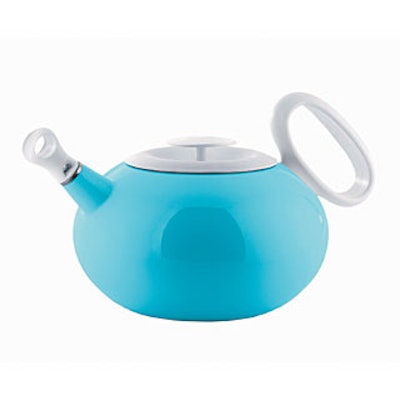
Rashid's Oingo kettle










